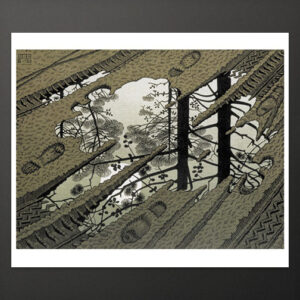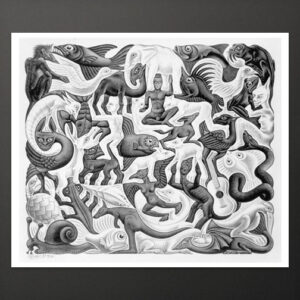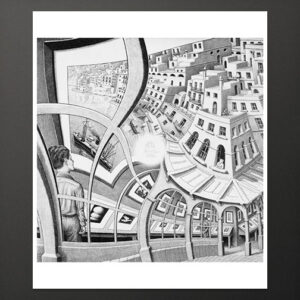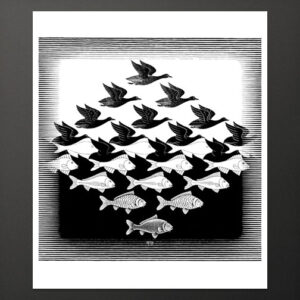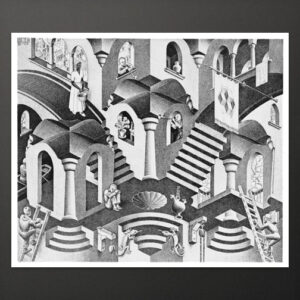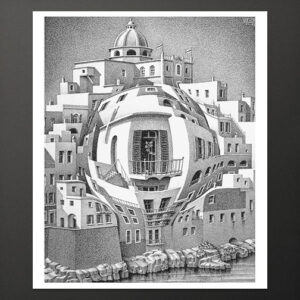-
Mud puddle, woodcut of 3 blocks, 1952. "The cloudless evening sky is reflected in a mud puddle left in the hollow of a forest road after a rain shower. Traces of two trucks, two bicycles and two pedestrians are imprinted in the marshy ground." ~ M.C. Escher, Grafiek en Tekeningen. Printed in color on 170gram paper. Paper size : 55 x 65 cm. Image size approx : 49 x 36,2 cm. Packaged in cardboard tube.
-
Liberation, lithograph, 1955. "On the uniform-gray surface of an unfurling strip of paper, a development takes place, from bottom to top, simultaneously in shape and contrast. Triangles, barely visible at first, turn into more complicated figures as their mutual color contrast increases. In the center they are completed as white and black birds. From here onwards they free themselves from each other and fly into the world as independent beings. That is why the paper strip on which they were drawn disappears." ~ M.C. Escher, Grafiek en Tekeningen. Printed in black and white on 170 gram paper. Paper size : 75 x 34 cm. Image size approx : 30 x 66 cm. Packaged in cardboard tube.
-
Plane Filling II, lithograph, 1957. "... They could also only be created after years of training with regular fillings. The recognizability of their components as natural objects plays an even more important role. Enjoyment in the difficult game, without symbolic ulterior motives, was the only real reason for their creation... The rectangularity of the entire surface is the only regularity that is still present here. Of the inner figures, only a few are bordered by four surrounding ones. The immediate environment of the frog consists of two figures; the guitar is bounded by three, the rooster by five, and the ostrich (if it is one) by six. The total number is only apparent after careful counting. " ~ M.C. Escher, Grafiek en Tekeningen. Printed in black and white on poster paper. Paper size : 55 x 65 cm. Image size approx : 55,5 x 47,5 cm. Packaged in cardboard tube.
-
Belvedere, lithograph, 1958 "In the foreground, bottom left, is a sheet of paper on which the edges of a cube have been drawn. Two circles indicate the places where edges cross each other. Which edge is in front, which is behind? Front and back at the same time is in a three -dimensional world is not possible and therefore cannot be depicted. But an object can be drawn that represents a different reality from above than from below. The boy sitting on the bench has such a cube-like absurdity in his hands. He looks thoughtfully at the impossible object and is apparently unaware that the belvedere behind him has been built in the same impossible way. On the floor of the lower platform, i.e. indoors, there is a ladder, along which two people are busy climbing. But when they arrive one floor higher, they are back in the open air and have to enter the building again. Is it any wonder that no one in the group cares about the fate of the prisoner in the basement, who puts his head through the bars, whimpering?" ~ M.C. Escher, Grafiek en Tekeningen. Printed in black and white on 170 gram paper. Paper size : 55 x 65 cm. Image size approx : 35 x 55 cm. Shipped in cardboard tube.
-
Print Gallery, lithograph, 1956. "[In this print an] enlargement towards the center, a ring-shaped expansion takes place, around the empty center, in the direction of a clock. At the bottom right we enter through a gate an exhibition gallery with prints on tables and on walls. First we pass a visitor with his hands behind his back and then, in the lower left corner, a young man who is already four times as big. His head has already expanded in proportion to his hand. He looks at the last print of a series on the wall and follows the details one by one: the boat, the water and the houses in the background. From there, his gaze continues to slide from left to right along increasingly larger blocks of houses down on the sloping roof that covers the exhibition gallery; that is where our tour began. The boy sees all these things as two-dimensional details of the print he is studying. Looking a little deeper, he sees himself, as part of the picture. " ~ M.C. Escher, Grafiek en Tekeningen. Printed in black and white on poster paper. Paper size : 55 x 65 cm. Image size approx : 47,2 x 46,3 cm. Packaged in cardboard tube.
-
Waterfall, lithograph, 1961. "In the same British Journal of Psychology article that inspired Ascending and Descending, R. Penrose published the perspective drawing of a triangle. A copy of which is reproduced here. It is composed of square beams placed at right angles to each other. If we follow all the parts of this construction one by one, no error can be discovered. Yet it is an impossible construct, because there are sudden changes in the interpretation of the distance between our eye and our object. The impossible triangle is applied three times. Falling water sets a mill wheel in motion and then flows slowly in a zigzag manner down a sloping chute between two towers to the point where the waterfall begins again. The miller has to add a bucket of water every now and then to eliminate losses due to evaporation. The two towers are the same height and yet the right one is one floor lower than the left." ~ M.C. Escher, Grafiek en Tekeningen. Printed in black and white on poster paper. Paper size : 55 x 65 cm. Image size approx : 40 x 50 cm. Packaged in cardboard tube.
-
Sky and Water I, woodcut, 1938. "In the horizontal center strip, birds and fish are equal. But we associate flying with the air, so for the black bird the four white fish surrounding it are the air in which it flies. In the same way, swimming reminds us of water, so the four black birds surrounding the fish become for him the water in which he swims." ~ M.C. Escher, Grafiek en Tekeningen. Printed in black and white on poster paper. Paper size : 55 x 65 cm. Image size : 50 x 50 cm. Packaged in cardboard tube.
-
Convex and Concave, lithograph, 1955. "Next to each other are three houses with a cross vault as a roof. The left one is seen externally, the right one internally and the middle one optionally from inside or outside. There are several such inversions on this picture shown; one of them is described here. There are two boys playing the flute. One on the left looks down on the roof of the middle house; if he climbs through his window he can jump onto the roof below. If he then jumps down again, he ends up one floor lower on the dark floor in front of the house. However, the right flute player sees that same cross vault above his head as a roof before him there is no floor, but a fathomless abyss." ~ M.C. Escher, Graphics and Drawings. Printed in black and white on 170 grams poster paper. Paper size : 55 x 65 cm. Image size : 56 x 47 cm. Packaged in cardboard tube.
-
Printed in black and white on poster paper. Packaged in cardboard tube. Paper size : 55 x 65 cm. Image size approx : 46,5 x 58,7 cm.

